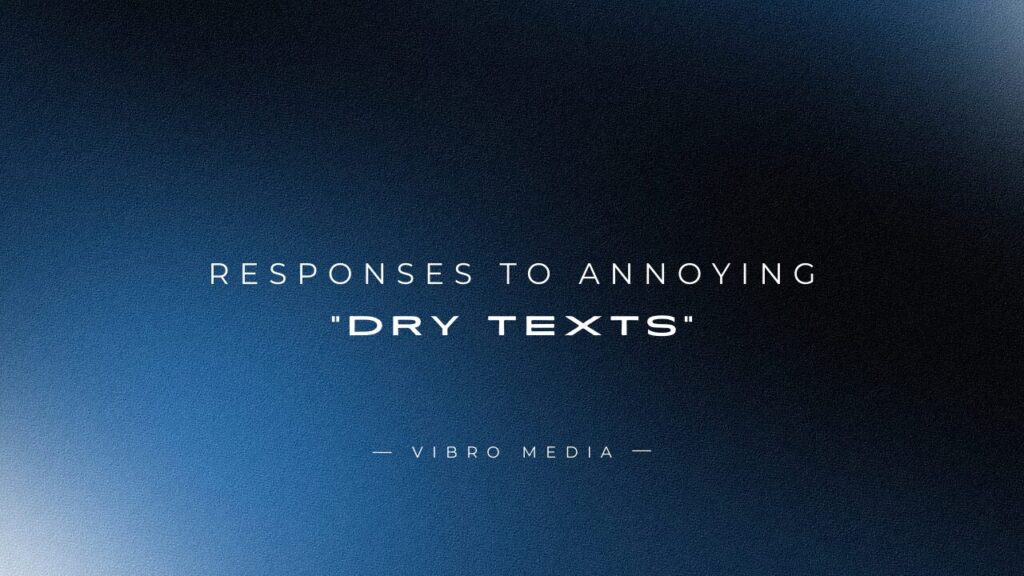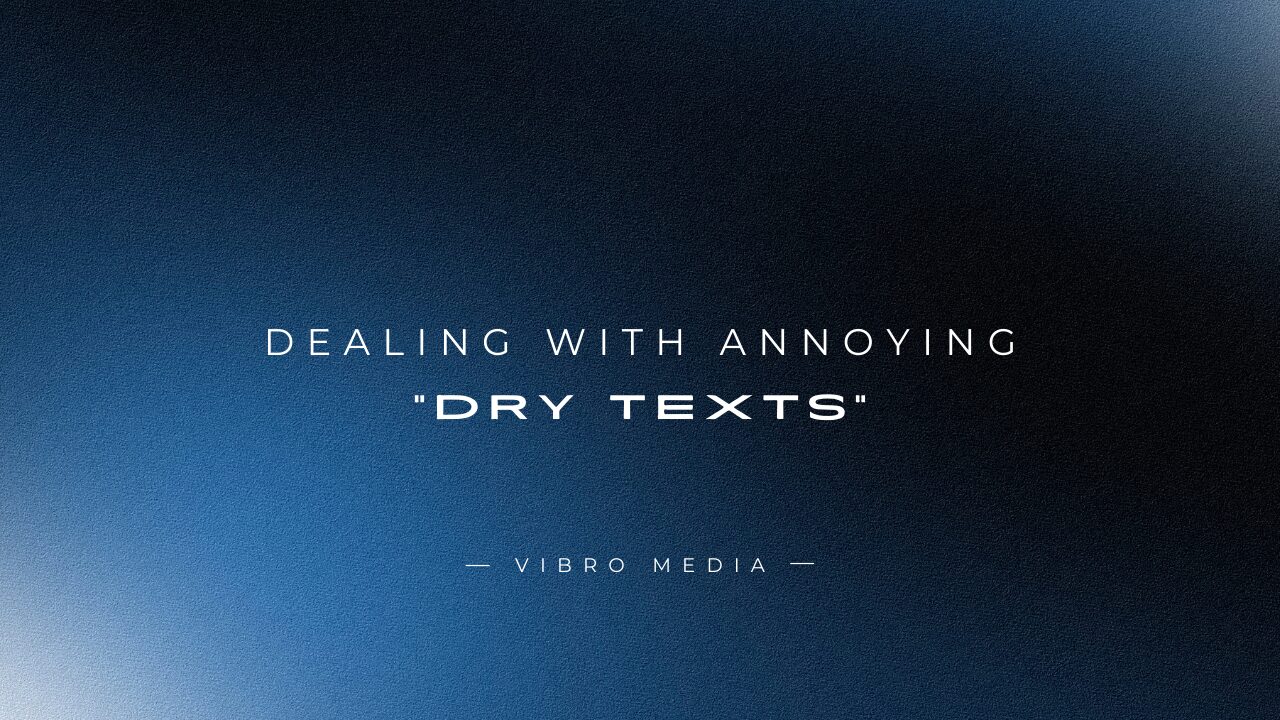Texting can be fun and easy, but it can feel like pulling teeth to keep the conversation going when you’re met with dry texts. Whether you’ve been the victim of a string of “yeah” and “k” responses or you’re the one dishing out the short replies, dealing with dry texts can make communication frustrating and awkward. But don’t worry—there are ways to manage and improve these situations. Let’s dive into how to handle annoying dry texts effectively!
Introduction to Dry Texts
- What are Dry Texts?
Dry texts are those short, unenthusiastic, and often one-word responses that can kill any momentum in a conversation. You know the type—when someone responds with “okay,” “cool,” or “lol” without offering anything for you to continue with. These messages make it hard to engage and leave you wondering if the other person is interested in talking.
- Why Do People Send Dry Texts?
People might send dry texts for various reasons. They could be busy, disinterested, or better at texting. Sometimes, they may need help keeping the conversation going or prefer in-person chats. Regardless of the reason, it’s important not to assume the worst immediately.
Understanding the Psychology Behind Dry Texting
- Is it Intentional or Unintentional?
In some cases, dry texting is unintentional. The person might not realize how short their messages are or how they’re coming across. Other times, it can be intentional, especially if they’re not invested in the conversation. Understanding whether it’s deliberate or just a bad habit can help you navigate your response.
- The Impact of Miscommunication in Texting
Texting is inherently limited in expressing tone, emotion, and intent. This can lead to misunderstandings and, in the case of dry texts, can leave one party feeling neglected or brushed off. It’s crucial to recognize that texting is just one communication medium; sometimes, people struggle to express themselves properly.

200+ Responses To Annoying Dry Texts
Sarcastic Responses
- Wow, your excitement is truly palpable.
- I can see you’re pouring your heart into this conversation.
- Your enthusiasm is so contagious; I’m practically bursting with energy.
- I’m on the edge of my seat with this riveting update.
- Is this what they call a ‘textual masterpiece’?
- You’re setting the bar high for emotional engagement.
- I didn’t know I’d receive my ‘Best Bored Text Ever’ award today.
- Your text is so thrilling that I almost forgot to breathe.
- That’s the most enthusiasm I’ve seen since… well, ever.
- Did you forget to add an ‘excited’ filter to your messages?
Blunt Acknowledgment
- Got it.
- Understood.
- Noted.
- Okay.
- Alright, thanks for the info.
- Message received.
- Seen.
- They are noted with thanks.
- Acknowledged.
- Thanks for letting me know.
Humorous Responses
- Is this your new way of texting in Morse code?
- My phone just took a nap reading that message.
- Your text was so thrilling; I need a moment to recover.
- Are you practicing for a ‘most boring text’ competition?
- I’d be broke if I had a dollar for every emotion in that message.
- Did you accidentally send me a sleep aid in text form?
- My phone just yawned. True story.
- Was that a text or a secret code for boredom?
- I didn’t realize we were having a minimalist texting challenge.
- Are you trying a new text format called ‘The Art of Disinterest’?
Polite Neutrality
- Thank you for the update. I’ll keep that in mind.
- Noted. Let me know if there’s anything else.
- I appreciate the information. We are moving forward from here.
- Thanks for letting me know. I’ll handle it accordingly.
- I got your message. Let’s proceed with the next steps.
- Thank you for your input. I’ll make a note of it.
- Understood. Please reach out if there’s more to discuss.
- Thanks for the update. I’ll review it and get back to you.
- Acknowledged. I am looking forward to the next part of our conversation.
- I appreciate the clarity. We’ll continue from here.
Passive-Aggressive Responses
- Seeing you’ve put in the effort with that response is nice.
- Well, that was a thrilling read. I almost fell asleep.
- I’m impressed by how brief and uninspiring that message was.
- I see someone’s really d in this conversation.
- You’ve mastered the art of the unengaging text.
- You’re passionate about keeping this conversation minimal.
- Your enthusiasm for this topic is just overwhelming.
- That message had all the excitement of a tax form.
- I’m amazed at how little effort you put into that response.
- Wow, that was a masterpiece of emotional depth.
Ignoring the Dryness
- Did you see the latest episode of that show we talked about?
- Have you made any progress on the project? I was thinking about our weekend plans. Any thoughts?
- Changing the subject, what did you think of that news article?
- On another note, how’s your new hobby going?
- I’m checking in to see how everything is on your end.
- Speaking of which, I need your input on something else.
- Since we’re talking, have you made any decisions about the event?
- Let’s move on to something more interesting. What’s new with you?
- While we’re at it, are there any updates on the other topic we discussed?
Reflecting the Tone
- Noted. I’ll leave it at that.
- I got it. Anything else?
- Okay, thanks for the brief update.
- Understood. Anything else you want to add?
- Alright. I’ll follow up if needed.
- Seen. Moving on.
- Noted. Will do.
- Understood. Nothing more to say.
- I got it. Will keI willhat in mind.
- Okay. I’ll take it from here.
Calling It Out
- Seems like you’re not into this conversation. Is everything okay?
- That’s a pretty dry response. Did I miss something?
- I notice you’re not very chatty today. Anything on your mind?
- Your texts are flat. Is there something you’d like to talk about?
- I’m getting the feeling you’re not interested in this topic. Am I wrong?
- It seems like you’re not putting much effort into these replies. Is everything alright?
- Your responses are unenthusiastic. Want to elaborate?
- I’m sensing some disinterest in your texts. Do you care to share why?
- The tone of your messages seems off. Anything you want to discuss?
- Your responses are really short. Is there a reason for that?
Overly Enthusiastic Replies
- Wow, that’s such an interesting update! I can’t wait to hear more!
- Amazing! I’m so excited to dive into this with you!
- Oh wow, this is fantastic news! Tell me everything!
- That’s incredible! I’m thrilled to hear more details!
- Fantastic! I’m super excited to discuss this further!
- This is so exciting! I’m all ears for the next update!
- I’m thrilled about this! I can’t wait to get into the details!
- Wow, I’m so pumped about this! Let’s keep the conversation going!
- This is awesome! I’m looking forward to hearing more!
- So exciting! I’m eager to see what comes next in this discussion!
Redirecting the Conversation
- You got it. Have you heard about the new restaurant opening downtown?
- Noted. On a different note, have you seen that new movie everyone’s talking about?
- Okay. Speaking of which, what are your thoughts on the upcoming project?
- Understood. Changing topics, how’s your new workout routine going?
- Alright. Have you reviewed the plans for our next meeting?
- You got it. What did you think of the latest episode of that show we like?
- Noted. Anyway, have you made any travel plans for the holidays?
- Understood. On another subject, have you tried out the new app I mentioned?
- Alright. So, how’s your family doing? Is there anything new with them?
- Got it. Speaking of updates, have you finished the report we discussed?
Emotionally Honest
- Your message felt distant. Is everything okay?
- I’m feeling a bit frustrated with the lack of detail. Could we try to be a bit more engaging?
- Honestly, this response could be more impressive. Is there something you’re not sharing?
- I’m a bit disappointed with how this conversation is going. Can we try to make it more interactive?
- I’m sensing some distance in your messages. Is there something on your mind?
- Your text felt flat. I’d appreciate a bit more enthusiasm if possible.
- I’m finding it hard to stay engaged with such brief responses. Can we discuss this in more detail?
- I feel like there’s a lack of energy in our conversation. Is there something we should address?
- I’m feeling a bit disconnected from these short replies. Can we make the conversation more meaningful?
- I’m a bit frustrated with how dry this chat is. Can we try to be a bit more interactive?
Professional Response
- Thank you for the update. I’ll proceed based on this information.
- Acknowledged. I’ll ensure this is taken into account moving forward.
- Thank you for your brief response. I will follow up if further details are needed.
- Noted. I’ll act on this as required and inform you of any developments.
- Understood. I’ll integrate this information into our planning.
- Thank you for the input. I’ll include this in our next steps.
- Received. I’ll address this in our ongoing project discussions.
- Thank you for the information. I will proceed with the next actions accordingly.
- Noted. I’ll update our records with this information.
- Understood. I’ll ensure that this is factored into our decision-making process.
Ghosting
- (No response—silence)
- (No response—silence)
- (No response—silence)
- (No response—silence)
- (No response—silence)
- (No response—silence)
- (No response—silence)
- (No response—silence)
- (No response—silence)
- (No response—silence)
Inquisitive Response
- Could you clarify what you mean by that? I’m not quite sure I understand.
- Please provide more detail on this topic.
- I’m curious—what’s your take on this matter?
- Could you expand on that? I’d love to hear more.
- What are your thoughts on the next steps?
- Is there more to this story? I want to get a fuller picture.
- Can you give me some more context here?
- I’m interested in your perspective. Could you elaborate?
- What specifically are you referring to? I’d appreciate more detail.
- Please explain that. I’m not sure I fully grasp it.
Empathetic Approach
- You may be having a tough time. If you want to talk about anything, I’m here.
- It seems like you’re not very engaged. Is there something bothering you that you want to discuss?
- I can tell you’re not your usual self. If there’s something on your mind, I’m ready to listen.
- I’m picking up on a bit of distance in your messages. Is everything okay with you?
- It seems like you’re not really into this conversation. If there’s something you need to talk about, let me know.
- I sense you might be experiencing something. I’m here to chat about it.
- Your messages need to be corrected. If you need to share something or are struggling, I’m here for you.
- Your responses are short. Feel free to reach out if you need support or want to talk.
- It sounds like you might be dealing with something. If you’d like to share or if there’s anything I can do, just let me know.
- I’m here if you need to talk. Your recent texts suggest you might be dealing with something, and I’m happy to listen.
Expressive Emojis
- Got it. 😐
- Thanks for the update. 🤔
- Alright. 🙄
- Understood. 😶
- Noted. 😒
- Okay. 😑
- Thanks for letting me know. 😴
- Got it. 😴
- Alright. 😕
- Understood. 😣
Confused Response
- I’m not quite sure what you mean. Could you explain?
- I’m a bit confused by that. Can you clarify?
- Sorry, I’m not sure I follow. Can you provide more details?
- I’m having trouble understanding your point. Can you elaborate?
- That response needed to be clarified. Could you help me understand?
- I’m not entirely sure what you’re getting at. Can you explain?
- Your message left me wanting clarification. What exactly are you referring to?
- I didn’t quite get that. Can you provide more context?
- I’m not sure I understand the message. Can you clarify what you mean?
- I’m a bit confused by the response. Could you give me a bit more information?
Compliment Sandwich
- Thanks for your update! I appreciate you keeping me informed. Please add more detail next time.
- I’m glad you reached out. Your quick response is great, but more enthusiasm would be even better.
- I appreciate your input. You’ve given a solid answer. It would be awesome if we could discuss it in more detail.
- Thanks for the message! It’s clear and to the point. If you could share more, I would appreciate it if you could get back to me. Your responses are always prompt. Adding more context would make them even better!
- It’s great to hear from you! I’ve noted your brevity. A bit more detail might help us both out.
- I’m glad you replied. Your messages are always clear. A bit more engagement would be appreciated!
- Thanks for your quick reply. I value your updates. Could you add more detail in future messages?
- I appreciate your response. It’s concise and to the point. More elaboration would be very helpful.
- Good to hear from you. I value your promptness. A touch more detail in your responses would be fantastic!
Redirecting Humor
- Got it! Anyway, did you catch that hilarious meme I sent you last week?
- Thanks for that update! Speaking of updates, did you hear about the latest prank I pulled?
- Understood. By the way, I need to hear your reaction to the most recent episode of that crazy show!
- Noted. On a lighter note, have you tried that new recipe I sent you? It’s a game-changer!
- Alright, thanks. What’s your opinion on that outrageous trend everyone’s talking about?
- You got it! By the way, did you see the funny cat video I forwarded? It’s worth a watch!
- Thanks for the info. On a different note, have you seen the latest viral dance challenge?
- Understood. Changing topics, did you hear about the new gadget that everyone’s raving about?
- Noted! So, how’s your collection of quirky coffee mugs going?
- Alright, thanks. By the way, did you see that hilarious clip of the dog who can ‘talk’?
Encouraging Engagement
- I appreciate the update. What’s your take on this topic? I’d love to hear more from you!
- Thanks for letting me know. Can you share more details? I’m interested in your thoughts.
- You got it. What’s your perspective on this? I’m curious to get your full opinion.
- Noted. Could you expect? I’d love to dive deeper into this with you.
- Thanks for the information. Would you be willing to explore this topic further? I’m eager to hear more from you.
- Understood. What’s your detailed view on this? I’m looking forward to a more in-depth discussion.
- I appreciate the brief update. Could you share more about your thoughts or ideas on this?
- Thanks for the message. Can you provide more insight? I’d love to understand your viewpoint better.
- I got it. What are your detailed thoughts on this? I’m interested in a more engaging discussion.
- Noted. I’d love to hear more about your perspective. Can you elaborate a bit?
Common Signs of Dry Texts
- Short and One-Word Responses
The biggest red flag of a dry text is the one-word response. Messages like “k,” “sure,” or “idk” are typically signs that the person isn’t fully engaged in the conversation.
- Lack of Engagement or Interest
If the person you’re texting never asks follow-up questions or seems to end every topic quickly, this is another sign of dry texting. It shows they aren’t invested in keeping the conversation alive.
- Delayed or Sporadic Responses
While everyone has a busy schedule, if someone regularly takes a long time to respond and sends minimal-effort texts when they do, it’s a sign that they’re not particularly interested in the conversation.
How to Handle Dry Texts Without Overthinking
- Stay Calm and Avoid Jumping to Conclusions
It’s easy to assume the worst when you receive a dry text, but sometimes people are tired, distracted, or not in the mood for lengthy conversations. Avoid jumping to conclusions too quickly about their feelings towards you.
- Evaluate the Context Before Responding
Consider the circumstances—are they at work, studying, or dealing with something personal? Sometimes, people just can’t give 100% to texting at all times, and that’s okay.
Effective Ways to Respond to Dry Texts
- Asking Open-Ended Questions
One way to get past the dry texts is by asking open-ended questions. This encourages the person to share more than just a one-word answer and can lead to a more engaging conversation.
- Using Humor to Lighten the Conversation
Humor is great for breaking the ice when the conversation feels flat. Sending a funny meme, joke, or comment can inject some life into an otherwise dull text thread.
- Changing the Topic to Reignite Engagement
If the current topic is dragging, try switching gears. Bring up something you know they’re passionate about to get the conversation moving again or introduce a new subject.
When to Recognize It’s Time to Let Go
- Consistent Lack of Effort
If dry texting becomes a regular habit and you feel like you’re the only one putting in the effort, it might be time to reconsider how much energy you’re putting into this relationship.
- Repeated Disinterest in Communication
At some point, if the other person consistently shows disinterest, it might be a sign that they’re not as invested in the relationship as you are. It’s important to recognize when to step back.
How to Prevent Dry Texts from Ruining Relationships
- Communication Styles and Expectations
Everyone has different communication styles. Some people prefer texting constantly, while others may only text occasionally. Understanding and respecting these differences can help prevent dry texts from becoming an issue.
- Establishing Boundaries and Understanding
Setting expectations early on about how often you’ll text or what kind of responses you both expect can help avoid any future confusion. It also ensures that neither person feels neglected.
Strategies for Keeping Conversations Engaging
- Sharing Personal Stories and Experiences
Sharing personal stories or experiences is a great way to keep a conversation lively. It keeps the chat interesting and helps build a deeper connection between you and the person.
- Asking Thought-Provoking Questions
Asking questions that make the other person think or reflect can create more meaningful conversations. These can range from “What’s been the highlight of your week?” to “What’s your opinion on…?”
- Using Visuals: Memes, GIFs, and Emojis
Sometimes, words just aren’t enough. Sending a meme, GIF, or emoji can convey emotions better than text and add a fun twist to the conversation.
What To Do If You’re the One Sending Dry Texts
- Self-Reflection on Communication Habits
If you’ve been guilty of sending dry texts, take a moment to reflect. Are you disengaged, or is there a reason behind your short responses? Understanding why you’re sending these texts can help improve your communication.
- Improving Your Texting Game
To step up your texting game, try being more responsive, engaging, and thoughtful in your replies. Show interest in the other person and offer more than just one-word answers.
How to Communicate Your Feelings About Dry Texts
- Addressing the Issue Calmly
If dry texts are bothering you, it’s okay to address it. Approach the conversation calmly and tell the person how you feel without accusing them.
- Offering Solutions for Better Conversations
Instead of just pointing out the problem, offer solutions. Suggest topics you can discuss or ask for a better time to chat when they’re more available.
How Technology Plays a Role in Dry Texting
- The Influence of Social Media on Communication
With the rise of social media, people are more accustomed to short, fast-paced interactions. This shift may contribute to dry texting as people get used to communicating with minimal effort.
- The Rise of Quick Messaging and the Decline of Meaningful Interaction
Technology has made it easier to send quick messages, but it’s also led to less meaningful communication. Sometimes, people get caught up in the speed and forget to be thoughtful in their responses.
Benefits of Overcoming Dry Texts
- Strengthening Personal Connections
When you push past the barriers of dry texting, you create opportunities for deeper, more meaningful connections with others.
- Improving Emotional Intelligence in Digital Conversations
Learning how to handle dry texts also improves your emotional intelligence. You become better at reading between the lines and understanding the nuances of digital conversations.
Conclusion
In conclusion, dealing with dry texts is no longer a hassle. With these 200+ responses, you can turn dull conversation into something fun, engaging, or meaningful. Whether you want to keep things lighthearted or dig a little deeper, you’ll always have the perfect reply on hand. And if you ever need help with more than just boring texts, check out:
How to Shut Down “Nosy People”: 200+ Best Comebacks
FAQs
People text dry for various reasons, including disinterest, being busy, or needing to know how to keep the conversation going. It’s not always intentional but can reflect their current mood or situation.
Q. How do you stop someone from dry texting?
Encourage open-ended questions, use humor, and introduce new topics to engage the conversation. You can also candidly discuss it if it becomes a recurring issue.
Q. Can dry texting be a sign of something deeper?
Yes, dry texting can sometimes indicate that the person is not interested or disengaged from the conversation or relationship. However, it can also be a temporary issue based on external factors.
Q. How do I confront someone about their dry texts?
Approach the conversation calmly and express how the dry texts make you feel. Suggest how to keep the conversations more engaging without blaming the other person.
Q. Should I stop talking to someone who only sends dry texts?
Suppose dry texts are consistent, and the person is not interested in meaningful communication. In that case, reevaluating how much energy you want to invest in that relationship may be worth it.











Techno rozen naturally like your web site however you need to take a look at the spelling on several of your posts. A number of them are rife with spelling problems and I find it very bothersome to tell the truth on the other hand I will surely come again again.
obviously like your web site but you have to check the spelling on quite a few of your posts. A number of them are rife with spelling problems and I find it very troublesome to tell the truth nevertheless I will definitely come back again.